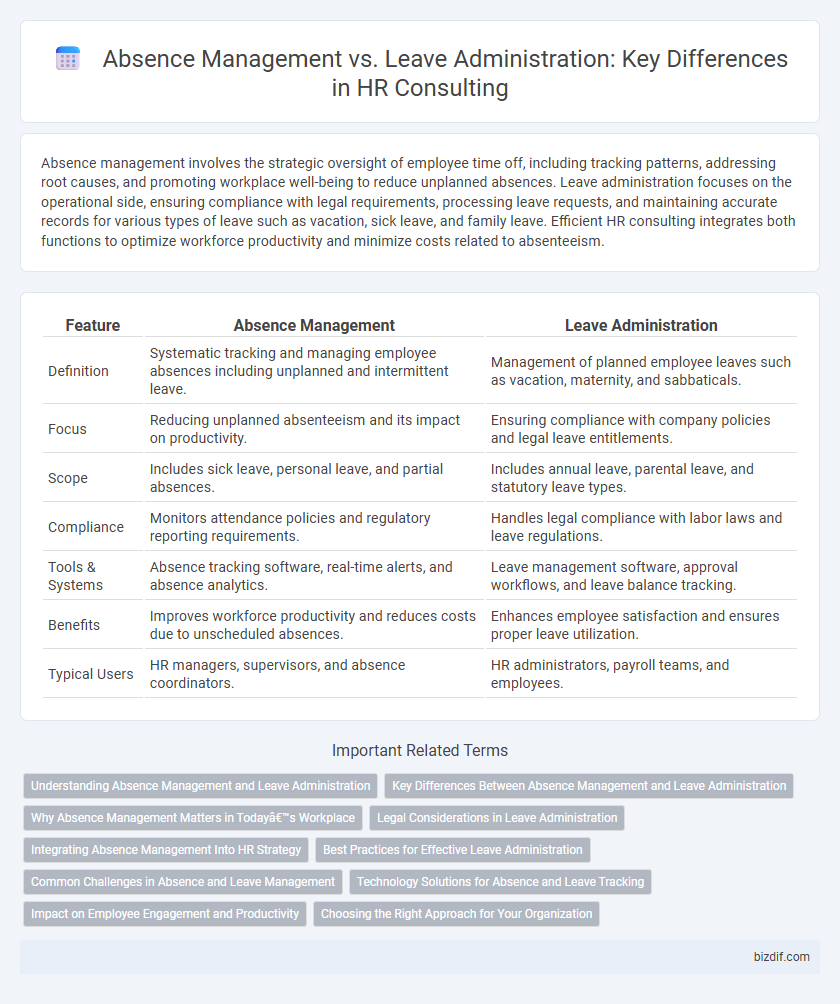Absence management involves the strategic oversight of employee time off, including tracking patterns, addressing root causes, and promoting workplace well-being to reduce unplanned absences. Leave administration focuses on the operational side, ensuring compliance with legal requirements, processing leave requests, and maintaining accurate records for various types of leave such as vacation, sick leave, and family leave. Efficient HR consulting integrates both functions to optimize workforce productivity and minimize costs related to absenteeism.
Table of Comparison
| Feature | Absence Management | Leave Administration |
|---|---|---|
| Definition | Systematic tracking and managing employee absences including unplanned and intermittent leave. | Management of planned employee leaves such as vacation, maternity, and sabbaticals. |
| Focus | Reducing unplanned absenteeism and its impact on productivity. | Ensuring compliance with company policies and legal leave entitlements. |
| Scope | Includes sick leave, personal leave, and partial absences. | Includes annual leave, parental leave, and statutory leave types. |
| Compliance | Monitors attendance policies and regulatory reporting requirements. | Handles legal compliance with labor laws and leave regulations. |
| Tools & Systems | Absence tracking software, real-time alerts, and absence analytics. | Leave management software, approval workflows, and leave balance tracking. |
| Benefits | Improves workforce productivity and reduces costs due to unscheduled absences. | Enhances employee satisfaction and ensures proper leave utilization. |
| Typical Users | HR managers, supervisors, and absence coordinators. | HR administrators, payroll teams, and employees. |
Understanding Absence Management and Leave Administration
Absence management involves tracking and addressing employee absences to maintain workforce productivity and compliance with labor laws, while leave administration specifically focuses on managing employee leave requests, entitlements, and documentation based on company policies and legal requirements. Effective absence management integrates data from leave administration systems to identify patterns, reduce absenteeism, and optimize resource planning. Leveraging HR software solutions enhances accuracy and efficiency in both absence management and leave administration processes.
Key Differences Between Absence Management and Leave Administration
Absence management encompasses the strategic process of tracking, analyzing, and reducing employee absenteeism to improve productivity and workforce planning. Leave administration specifically handles the operational aspects of employee leave requests, approvals, and compliance with labor laws such as FMLA or ADA. Key differences include absence management focusing on overall absence patterns and organizational impact, while leave administration concentrates on individual leave entitlements and legal adherence.
Why Absence Management Matters in Today’s Workplace
Effective absence management reduces unplanned employee downtime, directly improving productivity and operational efficiency in today's competitive workplaces. It integrates data-driven tracking systems that help identify patterns, enabling proactive interventions and better workforce planning. Prioritizing absence management supports employee well-being, reduces costs related to absenteeism, and maintains compliance with evolving labor regulations.
Legal Considerations in Leave Administration
Leave administration involves strict adherence to employment laws such as the Family and Medical Leave Act (FMLA), the Americans with Disabilities Act (ADA), and state-specific regulations that protect employee rights and outline employer obligations. Accurate documentation and timely communication are critical to ensure compliance and mitigate legal risks related to unauthorized absences or disputes over leave entitlements. Employers must also implement unbiased policies and consistent application to avoid discrimination claims and penalties under labor laws.
Integrating Absence Management Into HR Strategy
Integrating absence management into HR strategy enhances employee productivity by systematically tracking and addressing attendance patterns, thereby reducing unplanned absences. Effective absence management aligns with organizational goals, supports compliance with labor laws, and improves workforce planning by leveraging data analytics for proactive interventions. This integration fosters a healthier workplace culture and optimizes resource allocation compared to traditional leave administration, which primarily focuses on processing leave requests.
Best Practices for Effective Leave Administration
Effective leave administration in HR consulting requires accurate tracking systems to monitor employee absences and comply with labor laws. Implementing clear policies and regular communication ensures transparency and minimizes misunderstandings while supporting workforce productivity. Leveraging technology platforms for automated leave requests and approvals enhances efficiency and data accuracy in absence management.
Common Challenges in Absence and Leave Management
Common challenges in absence management and leave administration include tracking employee time off accurately, ensuring compliance with labor laws such as the Family and Medical Leave Act (FMLA), and managing the integration of various leave types like sick leave, vacation, and disability leave. HR professionals often face difficulties in maintaining real-time data visibility and preventing unauthorized absences, which can lead to operational disruptions and increased costs. Implementing automated absence tracking systems and clear leave policies helps mitigate errors and improve overall workforce productivity.
Technology Solutions for Absence and Leave Tracking
Technology solutions for absence and leave tracking streamline HR consulting by automating data collection, ensuring compliance with labor regulations, and providing real-time analytics on employee attendance patterns. Advanced absence management systems integrate predictive analytics and AI-driven insights to minimize unplanned absences and optimize workforce productivity. Leave administration software enhances accuracy in leave balance calculations and simplifies approval workflows, reducing manual errors and administrative overhead.
Impact on Employee Engagement and Productivity
Effective absence management reduces unplanned disruptions by proactively addressing attendance issues, which directly enhances employee engagement and productivity. In contrast, leave administration primarily focuses on compliance and record-keeping, with limited influence on employee morale or work output. Implementing strategic absence management aligns organizational goals with workforce well-being, resulting in higher retention rates and consistent performance.
Choosing the Right Approach for Your Organization
Absence management and leave administration are distinct yet complementary HR functions essential for workforce efficiency. Absence management focuses on tracking and addressing unplanned employee absences to minimize productivity loss, while leave administration ensures compliance with legal regulations such as FMLA, ADA, and state-specific leave laws by managing planned employee leaves. Selecting the right approach depends on organizational size, industry compliance requirements, and the balance between operational efficiency and employee support.
Absence Management vs Leave Administration Infographic

 bizdif.com
bizdif.com